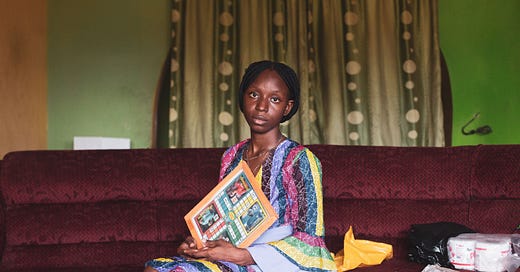Why is a ludo board held up by a slender hand? Why does a pack of toilet paper lie on a sofa? How long has it been since the first tear appeared on the sofa? When was the last time the plastic table was cleaned of dust? What is the content of the yellow bag? Where in the house is this? These are questions whose answers might offset the patient, probing glance of the young woman.
Nnebuifé Kwubeï: “I chase light and shadows.”
The photograph was taken in Ibadan.
Ekene (the model) is from my hometown. She reminds me a lot about home. It’s always a thrill to converse with her in our Ika language. I took this photograph of her in the living room of a lodge in Ibadan. She was there for her NYSC and together with a few other friends, I would go there and visit her and just engage in a lot of camaraderie. All of us were classmates in UNIBEN.
Nostalgia overwhelms me. That’s what a lot of my photographs are about. I am trying to reenact the memories and feelings I had before my grandmother's passing. I hadn’t started taking photographs or writing then. Ekene in this photograph is a memory place, a reminiscence, a familiar feeling, a warm welcome and a caring calloused hand repeatedly rubbing my head. Ekene is a reminder of what it felt like. Any time we converse in that familiar language, I always remember to be nostalgic.
I chase light and shadows. I try to find loneliness and nostalgia in my photographs and I try to strip my photographs off distractions and hide that which is unimportant to me
It’s important to tell stories and especially via texts but photography takes storytelling to a whole new level. It’s more relatable, it triggers change enabling emotions, contextualizes experiences and fosters in-person connections for observers. Seeing is believing and a photograph is worth a thousand words, right? For me, words fail me a lot and so photography affords me the opportunity to lay bare in visuals what I cannot say in words.
Two other photographs by Nnebuifé Kwubeï
About Nnebuifé Kwubeï
Fascinated by the evocative and contrasting powers of shadows, Kwubeï makes an extensive use of the chiaroscuro technique in his signature black and white portraits, creating striking images infused with tender melancholia and cunning poetry. Exploring the themes of translation and placement within time, societal constructs, his works carefully documents his people’s cultures and heritage, subtly blurring the lines between past and present, thus echoing the Ika conception of culture as an unending cycle of movement, always changing and never permanent. Learn more about his work on Instagram, and through this feature in Lolwe magazine.
Last Week — Neo Baepi
Even in its earliest forms, photography was intended to be an efficient visual medium. Paintings took too long, and moving pictures came much later. Taking a photo, as tedious as it was in the earlier times, was "easy." I also believe in it very deeply as a way to document moments in time and as a means to hold us all accountable to our development. For example, different peoples came to be photographed for different reasons — I think we owe it to ourselves to interrogate that.
Read More: Altar Boys
Support TENDER PHOTO
This is the 42nd edition of this publication. The newsletter can also read on web (best for viewing images), and via the Substack iOS/Android apps. Every week I feature one photograph and the photographer who took it: you’d read a short caption from me, and a statement from the photographer. My goal is to set up conversations with the work of early to mid-career African photographers. If this newsletter was shared with you, consider subscribing, and if you have already subscribed, please forward to a friend who loves photography.








Amazing photos, thanks for sharing all this. Learnt a lot.
This is nice